Search results for: 'Rom'
-
 Gruppe: 3 Skythische Pfeilspitzen (A-C)
Gruppe: 3 Skythische Pfeilspitzen (A-C)Dreiflüglig, Bronze, ohne Schaft. Typisch für Skythen ab ca. 700 v.Chr. Vermutlich jünger und von Söldnern im römischen Reich. Ca. 15mm bis 25mm.
Price: on request 2 Skythische 3-flüglige Pfeilspitzen aus Bronze (AB)
2 Skythische 3-flüglige Pfeilspitzen aus Bronze (AB)Dreiflüglig, Bronze, ohne Schaft. Typisch für Skythen ab ca. 700 v.Chr. Vermutlich jünger und von Söldnern im römischen Reich. Ca. 15mm bis 25mm.
Price: on request 2 Skythische bis römische 3-flüglige Pfeilspitzen aus Bronze
2 Skythische bis römische 3-flüglige Pfeilspitzen aus BronzeDreiflüglig, Bronze, ohne Schaft. Typisch für Skythen ab ca. 700 v.Chr. Vermutlich jünger und von Söldnern im römischen Reich. 41mm, 17mm.
Price: on request Skythische Pfeilspitzen aus Bronze
Skythische Pfeilspitzen aus Bronze2 antike Bronzepfeilspitzen. Dreiflüglig, gute Erhaltung. Typisch für Skythische Völker ab ca. 700 v.Chr. Aus dem danubischen Raum.
Price: on request Sehr schöne skythische Pfeilspitze
Sehr schöne skythische Pfeilspitzeantike Bronzepfeilspitze. Dreiflüglig, sehr gute Erhaltung mit Patina. Typisch für Skythische Völker ab ca. 700 v.Chr.
Price: on request Skythische Pfeilspitzen aus Bronze
Skythische Pfeilspitzen aus Bronze2 antike Bronzepfeilspitzen. Dreiflüglig, sehr gute Erhaltung. Typisch für Skythische Völker ab ca. 700 v.Chr. Aus dem danubischen Raum.
Price: on request 3 Skythische 3-flüglige Pfeilspitzen aus Bronze
3 Skythische 3-flüglige Pfeilspitzen aus BronzeDreiflüglig, Bronze, ohne Schaft. Typisch für Skythen ab ca. 700 v.Chr. Vermutlich jünger und von Söldnern im römischen Reich. 27mm, 18mm und 19mm lang.
Price: on request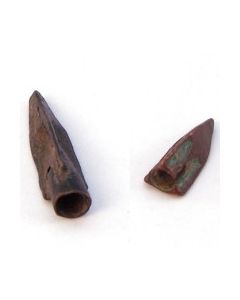 2 Skythische 3-flüglige Pfeilspitzen aus Bronze
2 Skythische 3-flüglige Pfeilspitzen aus BronzeDreiflüglig, Bronze, ohne Schaft. Typisch für Skythen ab ca. 700 v.Chr. Vermutlich jünger und von Söldnern im römischen Reich. 25mm und 16mm lang.
Price: on request 5 Skythische 3-flüglige Pfeilspitzen aus Bronze
5 Skythische 3-flüglige Pfeilspitzen aus BronzeDreiflüglig, Bronze, ohne Schaft. Typisch für Skythen ab ca. 700 v.Chr. Vermutlich jünger und von Söldnern im römischen Reich. 25mm, 23mm, 22mm, 17mm, 25mm.
Price: on request 2 Skythische bis römische 3-flüglige Pfeilspitzen aus Bronze
2 Skythische bis römische 3-flüglige Pfeilspitzen aus BronzeDreiflüglig, Bronze, ohne Schaft. Typisch für Skythen ab ca. 700 v.Chr. Vermutlich jünger und von Söldnern im römischen Reich. 21mm, 37mm.
Price: on request 2 Skythische bis römische 3-flüglige Pfeilspitzen aus Bronze
2 Skythische bis römische 3-flüglige Pfeilspitzen aus BronzeDreiflüglig, Bronze, ohne Schaft. Typisch für Skythen ab ca. 700 v.Chr. Vermutlich jünger und von Söldnern im römischen Reich. 25mm, 39mm.
Price: on request 2 Skythische bis römische 3-flüglige Pfeilspitzen aus Bronze
2 Skythische bis römische 3-flüglige Pfeilspitzen aus BronzeDreiflüglig, Bronze, ohne Schaft. Typisch für Skythen ab ca. 700 v.Chr. Vermutlich jünger und von Söldnern im römischen Reich. 23mm, 19mm.
Price: on request Gruppe: 5 Skythische Pfeilspitzen (A-E)
Gruppe: 5 Skythische Pfeilspitzen (A-E)Dreiflüglig, Bronze, ohne Schaft. Typisch für Skythen ab ca. 700 v.Chr. Vermutlich jünger und von Söldnern im römischen Reich. Ca. 15mm bis 25mm.
Price: on request Gruppe: 5 Skythische Pfeilspitzen (F-J)
Gruppe: 5 Skythische Pfeilspitzen (F-J)Dreiflüglig, Bronze, ohne Schaft. Typisch für Skythen ab ca. 700 v.Chr. Vermutlich jünger und von Söldnern im römischen Reich. Ca. 15mm bis 25mm.
Price: on request Melon bracelet from the Hallstatt period
Melon bracelet from the Hallstatt periodThe massive bronze bracelet was found in Mintraching, Germany. The piece is published in an archeological report. Around 600 BC.
Price: on request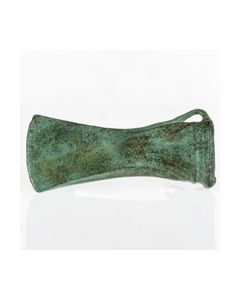 Socketed axe head from Southern Germany
Socketed axe head from Southern GermanyA typical bronze tool of the late Urnfield culture or early Hallstatt culture. It was found near Regensburg in Southern Germany by a voluntary archaeologist.
Price: on request Early fibula from Magna Graecia
Early fibula from Magna GraeciaGreek silver brooch and piece of jewellery from the South Italian colonies. Geometric period.
Price: on request Villanovan fibula from the Hattatt collection
Villanovan fibula from the Hattatt collectionBronze brooch of the Italic Iron Age. The piece is published in the standard work "Brooches of Antiquity".
Price: on request Villanovan fibula from the Hattatt collection
Villanovan fibula from the Hattatt collectionSerpentine bronze brooch of the Italic Iron Age. The piece is published in the standard work "Brooches of Antiquity".
Price: on request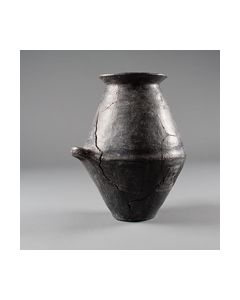 Funerary urn from the Villanova culture - found in Chiusi, Italy
Funerary urn from the Villanova culture - found in Chiusi, ItalyKeramik aus dem 9. Jh. v. Chr., unmittelbar vor der etruskischen Besiedelung. Ritzdekor aus Swastika und anderen geometrischen Elementen. Gefunden in Chiusi, Norditalien.
Price: on request Clay rattle shaped as a bird from the Lusatian culture
Clay rattle shaped as a bird from the Lusatian cultureRassel in Form eines Hauses. Aus dem Übergang der Späten Bronzezeit zur Frühen Eisenzeit Nordmittel-Europas. 1300 bis 500 v. Chr.
Price: on request Small bowl from the Lusatian culture
Small bowl from the Lusatian cultureKleines Schälchen aus grober Keramik. Möglicherweise Votivgabe oder Grabbeigabe für Kinder.
Price: on request Small flat bowl from the Lusatian culture
Small flat bowl from the Lusatian cultureKleines, flaches Trinkschälchen mit Henkel. Möglicherweise Votivgabe oder Grabbeigabe für Kinder. Museale Erhaltung, keine Schäden oder Risse.
Price: on request Juglet from the Urnfield period
Juglet from the Urnfield periodSmall juglet dating to the transition period between Bronze Age and Iron Age in Central Europe. 1200 to 800 BC. Found in an urnfield in Lower Austria.
Price: on request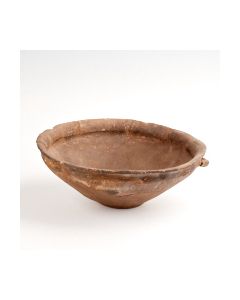 Big bowl from the Urnfield period
Big bowl from the Urnfield periodCeramic vessel dating to the transition period between Bronze Age and Iron Age in Central Europe. 1200 to 800 BC. Found in an urnfield in Lower Austria.
Price: on request Large Villanovan fibula from the Hattatt collection
Large Villanovan fibula from the Hattatt collectionImposing bronze brooch of the Italic Iron Age. The piece is published in the standard work "Brooches of Antiquity".
Price: on request Phrygian fibula from the Hattatt collection
Phrygian fibula from the Hattatt collectionBronze fibula from Anatolia around the time of King Midas. The piece is published in two standard works and was on loan to the Ashmolean Museum.
Price: on request Sword of the Urnfield culture from a museum collection
Sword of the Urnfield culture from a museum collectionWonderfully preserved bronze weapon from the time around 1000 BC. It was made in Central Europe by the Urnfield culture and formed part of a museum collection for almost 70 years.
€13,500 Iron Age spearhead from Sweden
Iron Age spearhead from SwedenWell-preserved iron weapon, a find from the Swedish province of Värmland. Acquired in 1894 into the collection of the Bally-Prior Museum.
Price: on request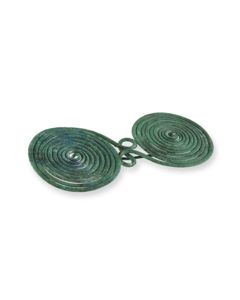 Magnificent spectacle brooch from Greece
Magnificent spectacle brooch from GreeceThe very large bronze brooch was made between the 9th and 6th century BC. It is formed by a single piece of wire. With an old expertise from Nefer Gallery.
€4,700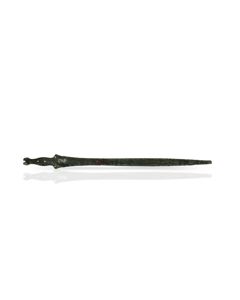 Sword from the Hallstatt period
Sword from the Hallstatt periodImpressive bronze weapon from the Early Iron Age around 700 BC. Made in the region of today's Germany or surrounding countries.
€4,550 Magnificent neck ring from Greece
Magnificent neck ring from GreeceThe solid bronze ring is beautifully decorated with spiral grooves and punched decoration. An impressive piece from the Iron Age. With expertise from 1987.
Price: on request

